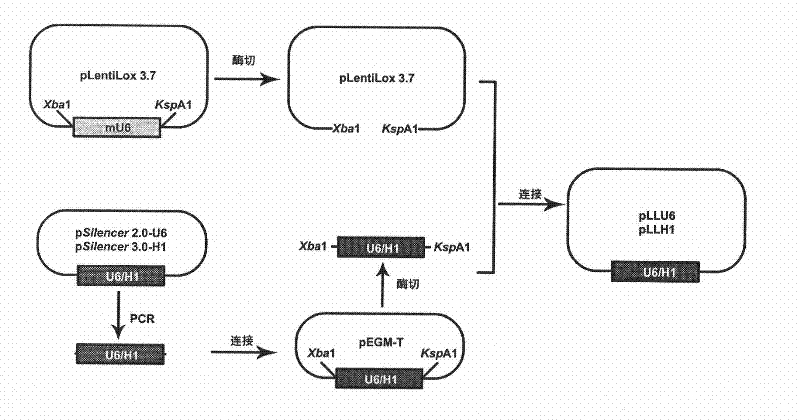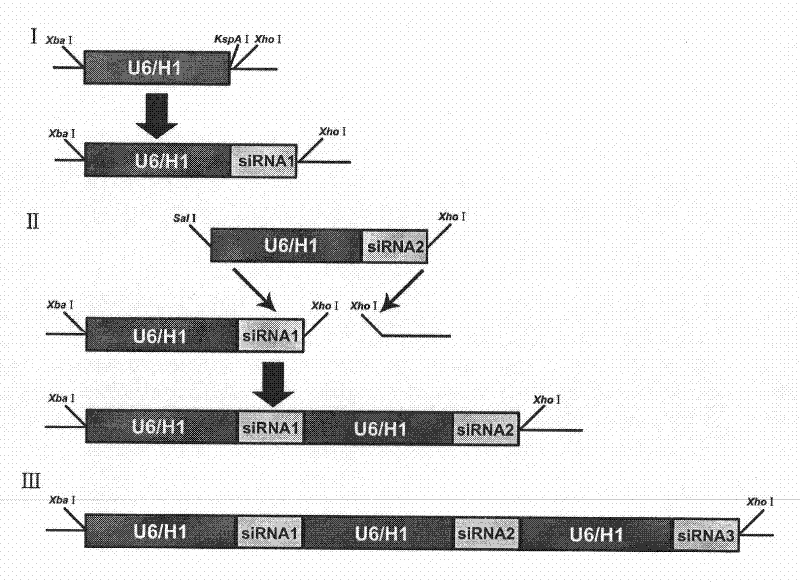Method for constructing tandem expression small interfering RNA recombinant lentiviral vector
A technology of recombinant lentivirus and lentiviral vector, applied in the field of molecular biology
- Summary
- Abstract
- Description
- Claims
- Application Information
AI Technical Summary
Problems solved by technology
Method used
Image
Examples
Embodiment 1
[0045] Example 1: Promoter modification of lentiviral vector
[0046] The lentiviral vector modified by the applicant is pLentiLox3.7 (Rubinson and Dillon, Nature Genetics, 2003). The vector contains a mouse U6 promoter to control the expression of siRNA, and also contains a reporter gene EGFP for flow cytometry sorting. In order to avoid homologous recombination caused by a single promoter of the tandem siRNA, resulting in the loss of the siRNA expression box, the applicant replaced the mouse U6 promoter of the vector with a human U6 promoter and a human H1 promoter (human U6 promoter and the human H1 promoter were obtained from Ambion's products pSilencer2.0_U6 and pSilencer3.0_H1 by PCR), and the transformed lentiviral vectors were named pLLU6 and pLLH1 respectively (Escherichia coli Stbl3 / pLLU6CCTCC M209135; Escherichia coli Stbl3 / pLLH1 CCTCC M 209136 ). For the schematic diagram of promoter transformation, see figure 1 shown. The specific transformation process is as...
Embodiment 2
[0062] Example 2: Construction method of tandem expression siRNA recombinant lentiviral vector
[0063] 2.1 Construction of single-target siRNA recombinant lentiviral vector (see figure 2 Step I)
[0064] 2.1.1 Chemically synthesized oligonucleotide chains, the format is as follows:
[0065] Sense strand: 5'-(19N)-(TTCAAGAGA)-(N91)-TTTTTTTC-3'
[0066] Antisense strand: Complementary to the sense strand with TCGA added at the 5' end to create Xho1 cohesive overhangs
[0067] Note: 1) 19N represents the 19-base sequence of the siRNA target, and N19 represents the reverse complementary sequence of 19N;
[0068] 2) (TCAAGAGA) guides the generation of the "loop" region of the siRNA precursor shRNA (small hairpin RNA),
[0069] The sequence was selected from (Brummelkamp et al., Science, 2002)
[0070] 2.1.2 Anneal the sense strand and antisense strand to form a fragment with Xho1 sticky end and blunt end;
[0071] 2.1.3 Ligate the above fragments to the vector pLLU6 or pLLH...
Embodiment 3
[0094] Example 3: Application example of lentiviral vector expressing siRNA in tandem
[0095] In order to verify whether the lentiviral vector expressing siRNA in tandem can work normally, the applicant explained with an application example of interfering with HIV:
[0096] In this example, the applicant selected the HIV genes rev, pol, tat and the host cell membrane protein CCR5 required for virus-infected cells as targets, and used the lentiviral vector for tandem expression of siRNA provided by the present invention to construct a single target Point, double-target, triple-target siRNA recombinant lentiviral vector. The combinations of siRNA expression cassettes are shown in the table below:
[0097] single target H1 CCR5 U6 rev U6 pol U6 tat double target H1 CCR5_U6 rev H1 CCR5_U6 pol H1 CCR5_U6 tat Three targets H1 CCR5_U6 rev_U6 pol H1 CCR5_U6 rev_U6 tat H1 CCR5_U6 poL_U6 tat
[0098]The applicant co-transfected HEK-293T cells with the ab...
PUM
 Login to View More
Login to View More Abstract
Description
Claims
Application Information
 Login to View More
Login to View More - R&D
- Intellectual Property
- Life Sciences
- Materials
- Tech Scout
- Unparalleled Data Quality
- Higher Quality Content
- 60% Fewer Hallucinations
Browse by: Latest US Patents, China's latest patents, Technical Efficacy Thesaurus, Application Domain, Technology Topic, Popular Technical Reports.
© 2025 PatSnap. All rights reserved.Legal|Privacy policy|Modern Slavery Act Transparency Statement|Sitemap|About US| Contact US: help@patsnap.com



